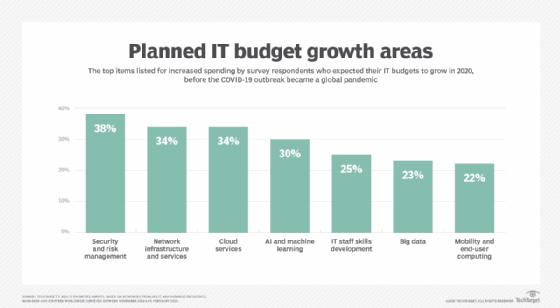CIO strategies for COVID-19 require new long-term IT planning
CIOs should look beyond the immediate IT requirements created by the COVID-19 outbreak and think about what will be needed in post-pandemic environments.
For IT teams, the immediate priority during the coronavirus crisis has been to ensure that organizations have the technologies they need to continue operating amid lockdowns and business restrictions. But CIO strategies for COVID-19 should also include longer-term planning to make sure IT environments can meet lasting new business needs that result from the pandemic, according to technology services providers and analysts.
The IT strategic planning process is complicated by the severity of the sudden economic downturn caused by the pandemic, which has sharply cut revenues for companies in various industries and forced businesses worldwide into short-term crisis management mode. In many cases, that includes reduced IT spending overall, at least in 2020.
"A lot of organizations are just concerned about survival at this point," Gartner analyst Paul Proctor said. "I'm talking to clients who have seen 100% loss of revenue. It's really dire out there right now." But even in the current situation, he added, CIOs "need to have some eye on the future" to align IT networks, systems and applications with post-pandemic enterprise demands in a cost-effective way.
For example, working from home is likely to become more institutionalized in organizations that have had to increase their remote work and collaboration capabilities because of the virus, Proctor said. Maintaining and upgrading those capabilities will require ongoing expenditures, and IT departments will also still need to invest in on-premises networks for workers who do return to the office. All of that must be accounted for in IT plans. Being flexible on where people work "is nice, but IT costs go up," he added.
This article is part of
The IT thought leader's guide to the future of work
Dual demands complicate CIO strategies for COVID-19
Jitin Agarwal, vice president of enterprise products at software development and consulting services firm EPAM Systems Inc. in Newtown, Pa., uses the phrase "survive and thrive" to describe the dual demands that IT executives face in the current situation.
 Jitin Agarwal
Jitin Agarwal
Focusing on both the short and long term creates a double-edged sword for CIOs to handle, especially in hard-hit organizations, Agarwal acknowledged. But he said that in addition to helping business operations get through the current crisis, CIOs should spend at least some time looking more strategically at the future technology requirements and priorities that will be spurred by the pandemic.
"The best ones are also thinking of how things will change and what impact does that have," Agarwal said. "It would be almost impossible to see it going back to business as usual."
That kind of thinking is partly why O.C. Tanner, an employee recognition and rewards company based in Salt Lake City, is going ahead as planned with the deployment this year of an SAP-based platform that includes a suite of SaaS applications for managing and analyzing recognition programs.
 Niel Nickolaisen
Niel Nickolaisen
Six years in the making, the new platform will be sold to customers on a monthly subscription basis in an effort to shift O.C. Tanner's revenue stream from plaques and other rewards to a software-based model, said Niel Nickolaisen, the company's senior vice president and CIO. "Before, the software was really a way to order an award," he said. "Now, the software itself has intrinsic value to organizations."
Company executives decided to continue fully funding the initiative now because of its strategic importance, Nickolaisen said. Early users will have an opportunity to try out the platform this summer, with general availability due by year's end.
Strategic alignment on IT budget growth
Respondents to TechTarget's 2020 IT Priorities Survey cited security, network infrastructure and services, and cloud services as the top three areas in which they expected their IT budget to increase this year. The survey was conducted in late 2019 and early 2020, before the virus outbreak became a pandemic, so some of the planned budget increases may well have changed. But those three items align with the kinds of technology investments that Proctor, Agarwal and other consultants expect to be included in CIO strategies for COVID-19 that look beyond the initial response to the pandemic.

For example, collaboration tools like Microsoft Teams are becoming all-in-one communication platforms for many business users, said Ben Niernberg, executive vice president at IT and managed services provider MNJ Technologies in Buffalo Grove, Ill. "I'm using my cellphone less than I ever have," he noted. "Teams is my new phone. I use that for calls now."
 Ben Niernberg
Ben Niernberg
But with all that traffic going over the internet now and likely continuing to do so in the future, many organizations will need more network bandwidth on their VPNs, Niernberg said. Stronger security protections will also be needed for remote work environments and digital transformation initiatives, he added. And increased cloud usage offers a way to speed up system deployments without requiring large capital expenditures upfront or making IT staffers install equipment in an on-premises data center.
A faster pace on digital transformation projects
Raj Patil, CEO and president of technology services firm Orion Innovation in Edison, N.J., thinks the pace of digital transformation projects will accelerate in response to the pandemic, with more organizations adopting three- to six-month project cycles with a reduced scope in order to deliver new functionality faster. "We were seeing that starting to happen before this, but I expect to see that become more widespread," he said.
 Raj Patil
Raj Patil
However, like Proctor, Patil said that as CIOs plan out IT strategies to support the new business processes emerging from the pandemic, they need to be conscious of the potential cost implications.
For example, cloud systems aren't necessarily less expensive than on-premises ones in the long run, since the monthly operating expenses to run them continue to add up, he cautioned.
"It's not as simple as just turning a switch on," Patil said. "To go to the cloud, you need to manage that spend, and companies have found that the economics don't always work."








